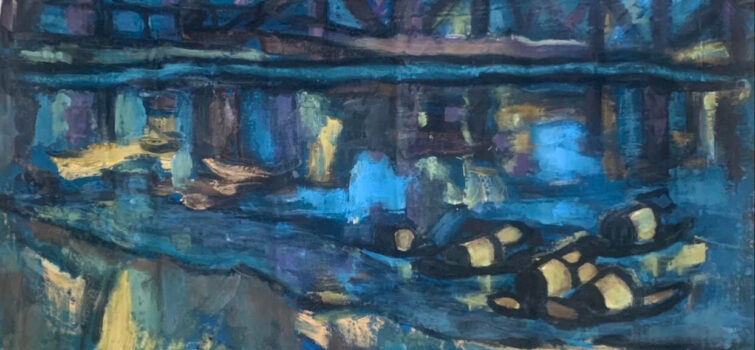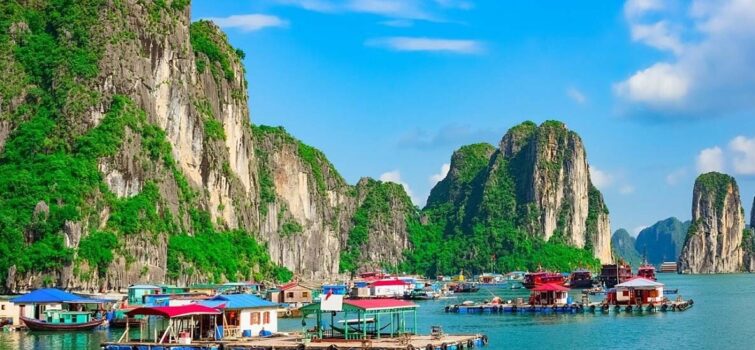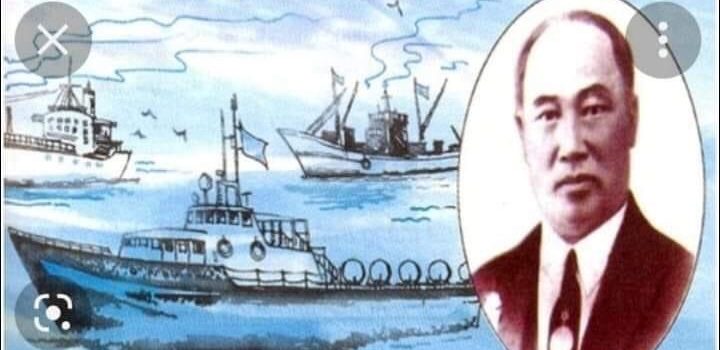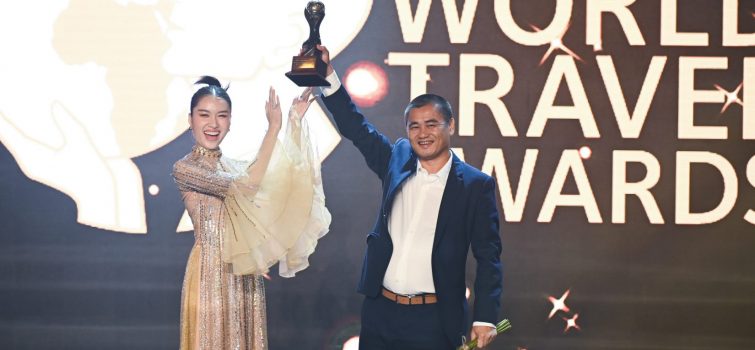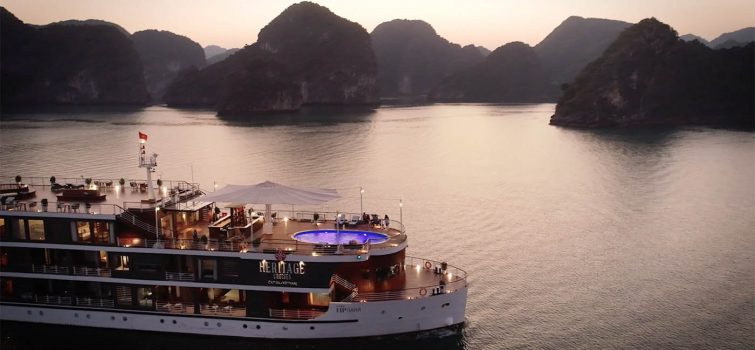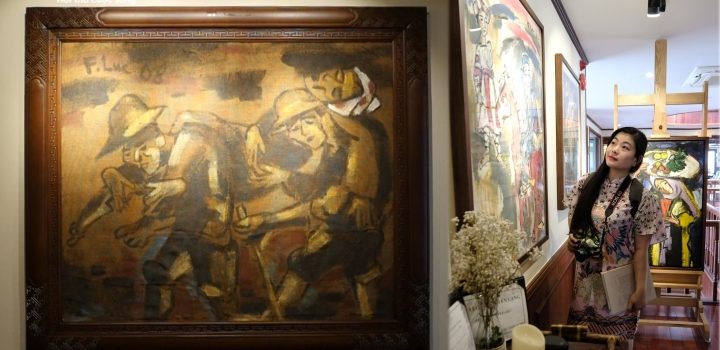Cruise along Ha Long Bay listed among 15 travel ideas to explore Vietnam’s hidden gems including Heritage Bình Chuẩn
Australia’s Lonely Planet Magazine has recommended 15 top travel experiences to discover the culture, cuisine and the hidden gems of Vietnam.
Ha Long Bay
It is said that cruise tour is the best way to explore the world heritage site Ha Long Bay, which is dotted with karst limestone mountains rising out of emerald waters.
For those who want a luxurious overnight stay to watch the sun come up on Ha Long Bay, Heritage Cruises, Indochine Cruise, Paradise Cruise and Stellar of the Seas are worth considering.
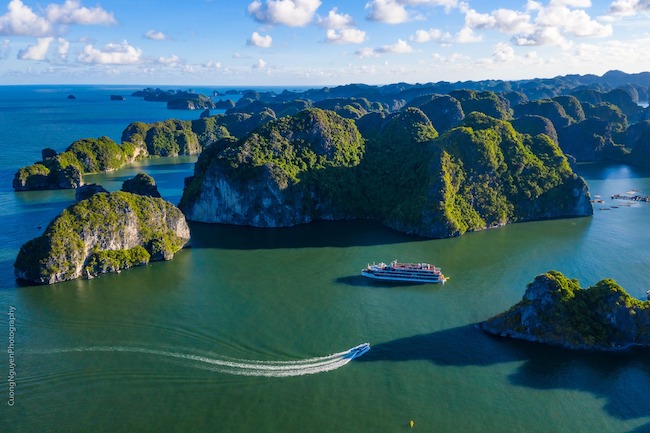 All five-star cruise ships in Ha Long are equipped with luxury cabins and modern amenities like bars, swimming pools, a golf club, a gym and spas.
All five-star cruise ships in Ha Long are equipped with luxury cabins and modern amenities like bars, swimming pools, a golf club, a gym and spas.
They also offer outdoor adventures like kayaking, cave exploring, onboard cooking classes, squid fishing at night and excursions to floating villages.
If Ha Long is crowded, its sister Bai Tu Long Bay is an alternative choice where there are still few tourists.
Other experiences include tasting Hue’s imperial cuisine, watching rare monkeys on Son Tra Peninsula, exploring a UNESCO-protected Hindu temple complex, visiting the Cao Dai Temple, jumping on a motorbike, conquering Ban Gioc Waterfall, breathing the fresh air in Da Lat, visiting Dak Lak’s coffee plantations, discovering Vietnam’s Maldives in Phu Yen…
Long Bien Bridge – the iconic French construction in the heart of Hanoi
Paul Doumer Bridge: Oil on Canvas, An artwork of Pham Luc.
Works on the bridge began in 1899 and when completed, in 1903, it was named after Paul Doumer, the French Governor General of Indochina. Visitors walking through the bridge could still see a metal plate attached to the truss which reads “1899 -1902 ~ Daydé & Pillé – Paris”. This is also the first steel bridge built across the Red River.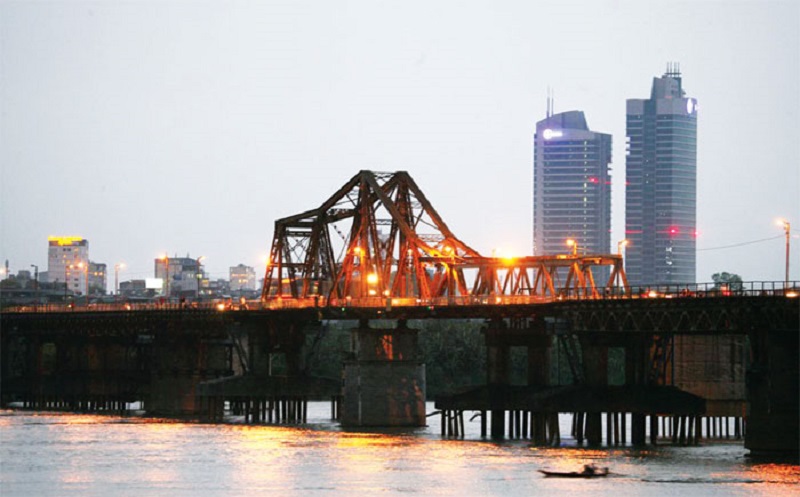
Long Bien bridge in the modern days/ Photo: Kinh te & Do thi
Long Bien Bridge is a reminder of French technological innovation at that time. Under the guidance of French experts, over 3,000 Vietnamese workers undertook the challenge of building the bridge, using up to 30,000 cubic meters of stones and metals, including 5600 tons of rolled steel, 137 tons of pig-iron, 165 tons of iron and seven tons of lead. The total cost of the bridge was up to 6,200,000 French francs at that time (roughly USD70 million today). Long Bien bridge construction period was originally planned to last 60 months, but it was completed in 45 months later.
According to the design of the French contractor Daydé & Pillé Company, the bridge’s length is 2290 across the river and 896 meters of stone approach roadway. Its 19 spans placed on 20 pillars in 40-meter-high (including the abutments). The single-track railway bridge runs in the middle while two side paths are used for motorbikes and bicycles (about 2.6-meters wide) and pedestrian way (about 0.4-meters wide). The direction on the Long Bien Bridge is left-hand traffic, instead of right-hand traffic like other bridges, meanwhile, cars are banned on the bridge.
The Long Bien bridge was almost destroyed by the US bombings during the years from 1965 to 1968, and in 1973 it was rebuilt.
In its more than 100-year history, Long Bien Bridge was once the second longest bridge in the world (just after the Brooklyn Bridge spanning the East-River in the US). It is even known as “the horizontal Eiffel Tower in Hanoi”.
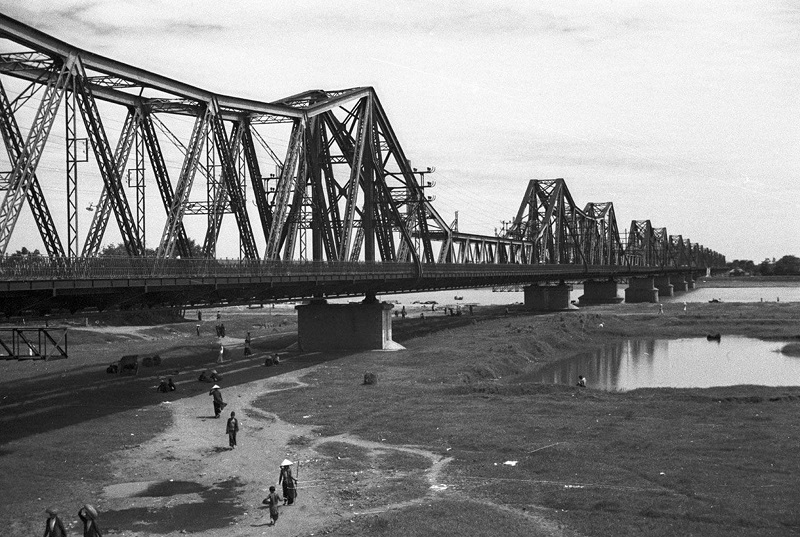
Long Bien Bridge in 1940s, the photo taken by unnamed French photographer.
The iconic French-built bridge has still remained an important part of daily life for residents of the capital. Teenagers, expats and tourists alike love to walk across it on the weekend, buying boiled glutinous corn or charcoal-grilled sweet potatoes.
The bridge is also the best place in town to watch the sunrise or sunset. Many brides and grooms as well as hip young local people choose Long Bien Bridge as the backdrop for their photos. In the afternoon, people in Ngoc Thuy village and Ngoc Thuy ward pick up fresh vegetables or fish for dinner from the small open-air afternoon market on the bridge.
Restoration efforts
Through many ups and downs of history and time, the bridge is seriously deteriorated. There have been several proposals put forward recently to modify and modernize the bridge, so that the city can tackle the increasing amount of traffic between the districts of Hoan Kiem and Long Bien.
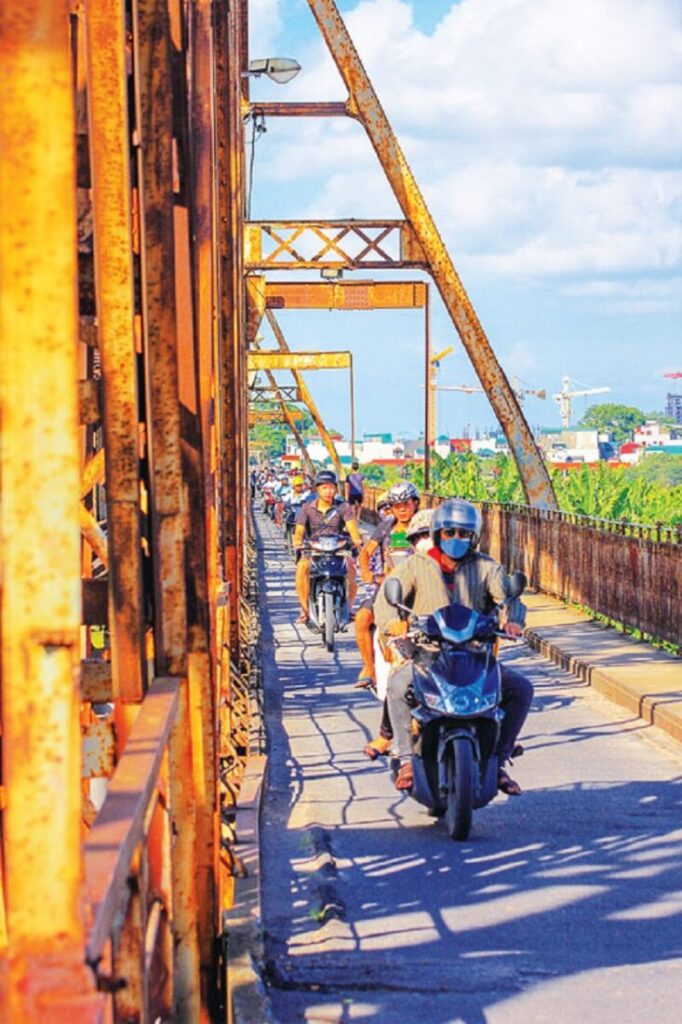 The bridge is an tourist attraction to both Vietnam and foreign travelers/ Photo: Kinh te & Do thi
The bridge is an tourist attraction to both Vietnam and foreign travelers/ Photo: Kinh te & Do thi
The most notable project is the one titled “Conservation, Renovation and Development of Long Bien Bridge” which has been cherished for more than 10 years by French- Vietnamese architect Nguyen Nga. In 2019, this project was officially released in Hanoi, with the help of the Association for Liaison with Overseas Vietnamese (ALOV).
According to Ambassador Nguyen Phu Binh, ALOV’s chairman, the project has initially received the support of Prime Minister Nguyen Xuan Phuc.
“Regarding the Long Bien bridge, the Prime Minister totally agreed to support Mrs. Nga’s initiative on the bridge restoration. He assigned the Government Office and the People’s Committee of Hanoi to discuss with Mrs. Nga and relevant agencies on the restoration. The Prime Minister requested the Vietnamese Ambassador to France to seek French support for the works and asked architect Nguyen Nga to mobilize capital sources to support the project,” Mr. Binh said.
Vietnam has one of world’s most beautiful coastal towns: US magazine
Cua Van Floating Village, in UNESCO world heritage site Ha Long Bay, has been named one of 16 most beautiful coastal towns by readers of U.S. magazine Travel+Leisure.
“This little village is completely composed of floating homes,” Travel+Leisure wrote. “About 700 people, traditionally fishermen, live in anchored houseboats, with kids attending a floating school.”
Located to the south of Ha Long Town, not far from Ha Long Bay, Cua Van Fishing Village is surrounded by limestone karst mountains.
The floating village has become a popular tourist attraction in recent years as visitors flock to there to see this unique way of life.
A majority of villagers have moved ashore, but several have chosen to maintain their livelihood in the floating village during daytime because the boats are their lifeline.
In 2015, the village was named the world’s most charming little town by Huffington Post, also based in the U.S.
Some of the other beautiful coastal towns featured on the Travel+Leisure list were Polperro in England, Manarola in Italy, Lunenburg in Canada and Port Fairy in Australia.
HANOI: The former capital of French Indochina and now the heart of the nation
In autumn of 1010, Emperor Ly Thai To decided to move the capital of the kingdom to Dai La (Hanoi today) from Hoa Lu (present Ninh Binh). He was mindful that the place was an ideal location with many advantages for wet rice farming and traffic thanks to a number of waterways, especially the Red River, the backyard of Ba Vi mountain, promising the long-term prosperous development of a capital and a nation. After moving the capital and renaming it Thang Long, Ly Cong Uan ordered the construction of a citadel to protect the city. Since then, Thang Long has become the political, economic, and cultural center of the country.
When the Nguyen dynasty was established in 1802, Emperor Gia Long moved the capital to Hue. Thang Long was no longer the capital, its Chinese characters was changed from 昇龍 (“Rising dragon”) to 昇隆 (“Ascent and prosperity”), aiming to reduce the sentiment of Le Dynasty. Emperors of Vietnam usually used dragon (龍 long) as a symbol of their imperial strength, and power. In 1831, the Nguyen emperor Minh Mang renamed it Hanoi (河內, “Between Rivers” or “River Interior”). Hanoi was occupied by the French in 1873 and passed to them ten years later. As Hanoi, it was located in the protectorate of Tonkin and became the capital of French Indochina after 1887.
 The city was occupied by the Imperial Japanese in 1940 and liberated in 1945, when it briefly became the seat of the Viet Minh government after Ho Chi Minh proclaimed the independence of Vietnam. However, the French returned and reoccupied the city in 1946. After nine years of fighting between the French and Viet Minh forces, Hanoi became the capital of an independent North Vietnam in 1954. The French Army withdrew that year and the People’s Army of Vietnam and International Control Commission occupied the city under the terms of the 1954 Geneva Conference. Following the end of the Vietnam and US war, Hanoi became the capital of a reunified Vietnam when North and South Vietnam were reunited on 2 July 1976.
The city was occupied by the Imperial Japanese in 1940 and liberated in 1945, when it briefly became the seat of the Viet Minh government after Ho Chi Minh proclaimed the independence of Vietnam. However, the French returned and reoccupied the city in 1946. After nine years of fighting between the French and Viet Minh forces, Hanoi became the capital of an independent North Vietnam in 1954. The French Army withdrew that year and the People’s Army of Vietnam and International Control Commission occupied the city under the terms of the 1954 Geneva Conference. Following the end of the Vietnam and US war, Hanoi became the capital of a reunified Vietnam when North and South Vietnam were reunited on 2 July 1976.
Today, Hanoi is still a city of rivers, of which the Red River is the largest. For Hanoians, the Red River is not only a source of life, it is also a reflection of Vietnamese history and the capital city’s long prosperity. Heritage buildings such as churches, grand cathedrals, opera houses, clocks, colonial buildings, villas, museums, palaces, river ports, and iron bridges remain unchanged though some have disappeared. Many boulevards with French names have changed to Vietnamese names. Regrettably, the heritage street Bach Thai Buoi was changed to Nguyen Huu Huan alley in 1954 on the bank of Red River, but his former two-story office houses in Hang Muoi Street remain intact facing the clock with his former inland waterway port near Chuong Duong Bridge.
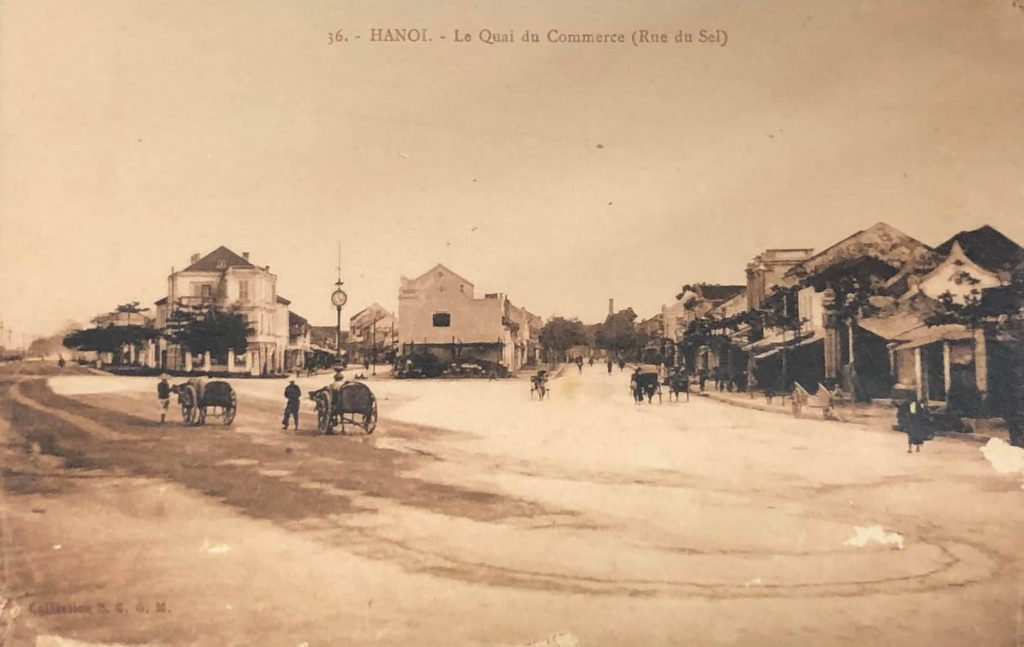 High-rise buildings are rare in this city which is striving to retain its character. Grand colonial buildings, tranquil lakes, and a maze of narrow streets provide intriguing contrasts. Hanoi is an elegant city with tranquil Hoan Kiem Lake (Grand Lac on postcards) at its heart. North of the lake are the bustling 36 guild streets of the Old Quarter, each street named after the trade that used to take place there. Hanoi is truly a city of contrasts with areas of wide boulevards and large colonial buildings, reflecting its period as a French Protectorate, and other areas truly Vietnamese with a muddle of narrow streets which bustle from dawn to dusk.
High-rise buildings are rare in this city which is striving to retain its character. Grand colonial buildings, tranquil lakes, and a maze of narrow streets provide intriguing contrasts. Hanoi is an elegant city with tranquil Hoan Kiem Lake (Grand Lac on postcards) at its heart. North of the lake are the bustling 36 guild streets of the Old Quarter, each street named after the trade that used to take place there. Hanoi is truly a city of contrasts with areas of wide boulevards and large colonial buildings, reflecting its period as a French Protectorate, and other areas truly Vietnamese with a muddle of narrow streets which bustle from dawn to dusk.
Similarly to the guilded age of Europe, “Hanoi’s 36 districts” is Vietnam’s version of the guild concept. In the past, as artisans moved to the capital city to do business, they gathered together in this area to share the resources and built communal houses and their temples. As a result, many of the streets were named after the crafts sold at that individual street. Pho Hang Muoi (Rue du Sel or Salt Street), Pho Hang Bun (Vermicelli), Pho Hang Ma (Paper Product), Pho Hang Bac (Silver), Pho Hang Non (palm-leaf conical hat), … are examples of the streets carrying the name of the products sold there. Explore my rich collection of postcards about Hanoi’s old guild streets and iconic buildings of the capital of Indochina and now the heart of Vietnam.
What is a travel management company?
Global business travel industry spending was expected to hit USD 1.7 trillion by 2022, and despite the crisis, business travel is bouncing back fast. It means many businesses are now looking for a TMC: Travel Management Company so that they’re as prepared as can be for when business travel returns to 100%.
A travel management company is essentially a travel agent or travel agency for corporate travel needs. As technology evolves, we’re beginning to see more personalized TMC solutions providing so much more than the ability to only book travel. Business travel programs need TMCs that are more tech-savvy than ever before.
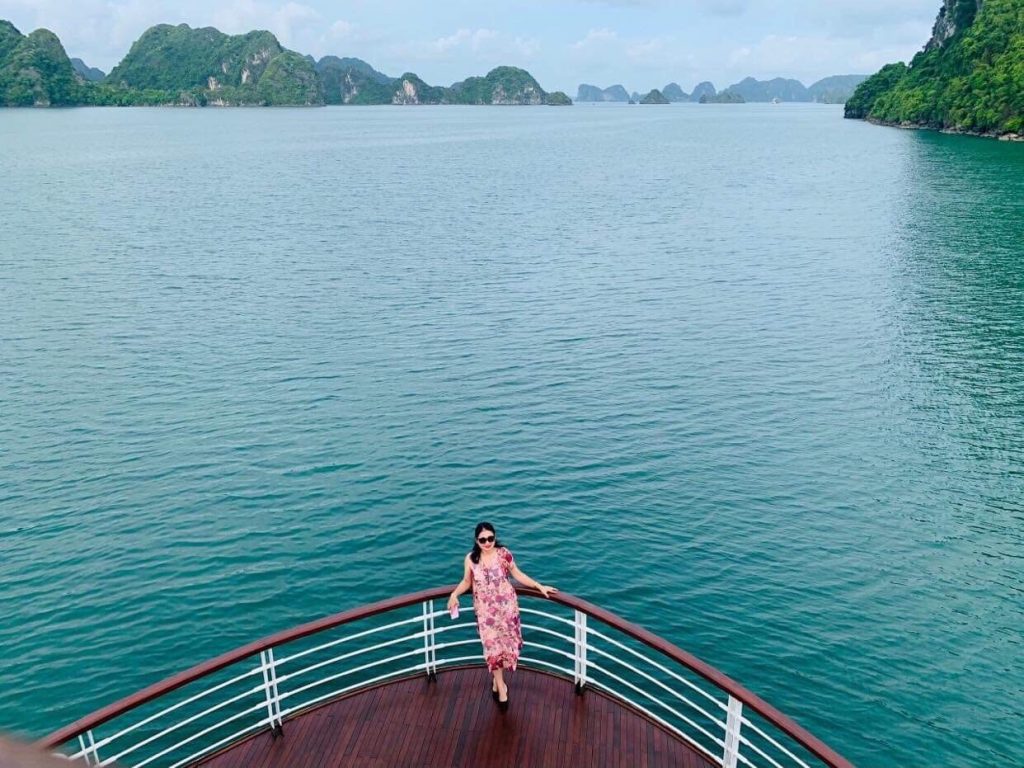
The Definition of a Travel Management Company (TMC)
A Travel Management Company (TMC) is a travel agent that fully manages the business travel requirements delegated by an individual, company or organisation to fundamentally save clients both time and money.
A TMC is also commonly known as a business travel agency or corporate travel provider.
As opposed to the traditional travel agent, which will usually deal with occasional leisure travel needs, a travel management company provides on-going services with the aim of providing cost savings, keeping control of a travel policy and allowing the client to spend less time on time-consuming travel arrangements.
A travel management company will typically use a GDS (Global Distribution System like Sabre or Amadeus) displaying real time availability to book flights, hotels and cars as well as other trusted software systems like Evolvi for train bookings.
Services Provided by a Travel Management Company
As well as simply making flight or hotel reservations, the TMC will offer many other ancillary services such as aircraft charter, airport lounges, parking and transfers, hotel bed requests, car hire, chauffeurs, foreign exchange, group travel, hotel bill backs, insurance, leisure travel, marine travel, meal requests, meet and greets, passport and visa procurement, rail tickets, roadshow services and venue sourcing.
Company and individual profiles are safely stored ensuring all personal travel requests are adhered to within an overall travel policy with every booking.
Other management services will often include MIS reporting, account management, risk management, cost/expense management, traveller tracking/security and travel policy adherence. Many TMCs will now also provide online self-booking tools whereby organisations can make their own flight and hotel reservations and bookings. Travel management companies will also typically negotiate with vendors/suppliers to provide discounted fares and loyalty programs.

The Future of the Global Travel Industry
What’s the future of the global travel industry? As economic prosperity rises throughout the world, the travel industry will be flooded by people from all over the world, and businesses are going to be at the forefront of this growth pushing their services to meet demand.
Expect the top 20 travel companies in the world to continues pushing the industry to new heights. The main thing to keep in mind going forward as more people travel from all over the world is that the future will be about more travelers and easier to reach places.
Rank Company Sales (USD billions) Headquarters No. of employees
1 Expedia Group $99 billion Bellevue, Washington, USA 24,000
2 Booking Holdings $92.7 billion Norwalk, Connecticut, USA 24,500
3 American Express Global Business Travel $33.7 billion Jersey City, New Jersey, USA 17,400
4 BCD Travel $27.1 billion Utrecht, Netherlands 13,800
5 CWT $25 billion Minneapolis, Minnesota, USA 18,000
6 Flight Centre $16 billion Brisbane, Queensland, Australia 20,600
7 Travel Leaders Group $7.12 billion New York City, New York, USA 4,000
8 American Express Travel $6.27 billion New York City, New York, USA 5,000
9 Direct Travel $5.4 billion Centennial, Colorado, USA 2,000
10 Corporate Travel Management $5 billion Denver, Colorado, USA 725
11 Fareportal $4.32 billion New York City, New York, USA 3,700
12 American Automobile Association $3.94 billion Heathrow, Florida, USA 4,401
13 Travel and Transport $3.2 billion New York City, New York, USA 1,610
14 Frosch $2.05 billion New York City, New York, USA 1,125
15 Omega World Travel $1.41 billion Fairfax, Virginia, USA 540
16 JTB Americas Group $1.37 billion Torrance, California, USA 2,234
17 World Travel $1.26 billion Exton, Pennsylvania, USA 523
18 World Travel Holdings $1.2 billion Wilmington, Massachusetts, USA 1,239
19 Ovation Travel Group $1.16 billion New York City, New York, USA 585
20 ATG $857 million New Albany, Ohio, USA
Vietnam Attracts the High-End Traveler
Luxury Travel in Vietnam on the Rise and Affordable
Vietnam is emerging as a luxury destination in the world tourism map, Mr. Pham Ha, a travel guru in the tourism industry in Vietnam reveals the current luxury travel trends and his products for 2022. Ha is the founder and CEO of Lux Group which is group of small giants including Lux Limo, Lux Mice, Lux Hotels and Resorts, Adventura Travel, Secret Hideaways, Lux Travel Dmc, Luxury Travel, Emperor and Heritage Cruises.
The Travel Experts of Virtuoso in the U.S. just completed a trend survey of its member agencies, each of whom specializes in catering to the needs of luxury travelers. The survey indicates that Vietnam and Cambodia are the hottest destinations in Southeast Asia.
“With new luxury hotels and world class golf courses having recently opened or set to open soon, and the introduction of luxury train journeys, exclusive cruises and upscale private tours spanning the length of the country, Vietnam is fast emerging as an exciting destination for the high-end traveler.” said Pham Ha.
Today’s luxury travelers want to be entertained and stimulated, rather than simply pampered, and Vietnam offers a magical mix of tropical beaches, post-colonial charm, a string of world heritage sites, stunning inland scenery, world-renowned cuisine and a home-grown flair for hospitality.
“Today, luxury travel is about experiences and doesn’t need to be limited to the super rich. Indeed, it is a little-known fact that almost anybody can afford to travel in style, elegance and comfort without breaking the bank or even spending much more than traveling ordinarily. The world of luxury travel is actually a very accessible one.” reveals Pham Ha.
Upscale tours today also offer “off the beaten track” experiences. In a credit crunch environment, high end tourists also expect efficiency, seamless travel, value for the money and a return on personal values. Many will opt for short trips for their families which offer a slice of local culture, a splash of adventure, and authentic experiences.
Upscale tailor-made tours in Vietnam now come replete with yacht, cruises, helicopter tours, limousine services, and the whole nine yards.
There is also plenty of flexibility for all tours. Travelers are free to request helicopter tours, cycling excursions to craft villages, scuba diving or snorkeling trips, reservations at the finest restaurants in the land, meetings with renowned artists, chefs and designers, shopping recommendations, spa reservations, tours with special-interest lecturers, and exclusive access to local activities and cultural events.
Each day, tours are designed with flexibility to suit travelers’ personal interests, schedule and energy level. When it comes to luxury tours, the sky’s truly the limit. Lux Travel DMC (www.luxtraveldmc.com) has just won a World Travel Awards 2022 as a Vietnam’s leading luxury destination management company confirming this trend and position of Vietnam luxury tourism in the world tourism map.
Best Boutique Cruise Line
Embark on a journey back in time to Vietnam in 1930s with Heritage Cruises Binh Chuan Cat Ba Archipelago boutique lifestyle cruise in Lan Ha Bay in Cat Ba Archipelago. Combining the classical charm of French Indochina with a sense of timeless chic that only the Lux Cruises can provide, the cruise is as much an art and heritage space as it is a 5 star cruise. Heritage Cruises Binh Chuan Cat Ba Archipelago invites guests to relive the romance of this bygone era in their boutique cruise which offers all the comforts of the 21st century.
The most luxurious cruise in Vietnam has many cultural features, bringing with it the stories of cultural and historical heritage, fine art, architecture, fashion, and the quintessence of Vietnamese cuisine. The yacht is newly built based on the Binh Chuan ship built by the ship king Bach Thai Buoi, the first Vietnamese to launch a ship from Hai Phong to Saigon. From the point of departure 100 years ago, today’s Heritage Cruises Binh Chuan takes travelers on a journey to discover Lan Ha Bay in style, a vast sea area with hundreds of islands, lagoons, and beaches, large and small, an experience recognized by the world. Channel 14 describes it “as beautiful as a dream” and Leonardo DiCaprio praises the ‘paradise’ beauty of Lan Ha Bay.
https://www.youtube.com/watch?v=45UNROguoNM&t
On the cruise, travelers can discover the authenticity of Lan Ha Bay, Binh Chuan Heritage Cruise will bring travelers into a traditional cultural space, the glorious legend of the intangible heritage, and enjoy the beauty of the natural heritage of Vietnam. Heritage Binh Chuan Cruise will bring the most authentic experiences with a minimum of 40 guests and a maximum of 60 passengers on a magnificent and sophisticated cruise operating in the Gulf of Tonkin. Savored travelers will immerse into the culture, history, art, and people of Vietnam when cruising on a unique cruise amidst natural wonders. On this heritage cruise, travel connoisseurs can go upstream of history and culture to learn the business story of “Vietnam’s king of ships” Bach Thai Buoi and the life of the “Vietnamese Picasso“, Pham Luc, through a rich collection of 100 of his works collected and introduced by the owner Pham Ha in various locations.
Heritage Binh Chuan received the most prestigious award, TripAdvisor 2022 Travelers’ Choice Awards “Best of The Best”. Luxury Lifestyle Awards 2020. Lux Cruises to expand the brand to Quy Nhon, Nha Trang, Phu Quoc in Kien Giang province, and Cat Ba archipelago in Hai Phong city, for unique yachting experiences in the coming year.” Start our first expeditions on the Gulf of Tonkin and further expand between Hanoi and Halong Bay on the Red River and its tributaries, along the coastline of Vietnam, on the Mekong River and to other Southeast Asia countries.
The Picasso of Vietnam – Painter Pham Luc
Painting is like exercising for painter Pham Luc. If he doesn’t paint something every day he feels slightly ill, which perhaps explains his prolific output and reputation as Vietnam’s Pablo Picasso.
Born in 1943, Luc has been around paint brushes for some 70 years. From the age of three he tried to turn things into paint brushes. It could be a piece of brick or charcoal, a tree branch, or a stone, and everywhere was his canvas. Often, he was scolded by his neighbors, whose house walls he used to express himself. Luckily, he later found a wide sand bank by the riverside near his home, where he could paint on the sandy canvas with a tree branch.
Growing up during wartime, the young Luc became a soldier after graduating from the Hanoi College of Fine Arts (now the Vietnam University of Fine Arts). But his passion for painting never ceased. As one of his hands held a gun, the other always held a brush. His constant companion has been paper, a brush, and colors. “The mission of a painter is to record what he observes,” Luc explained, “Life is so colorful. I don’t want to miss a thing.”
At times so focused on not missing a moment of life, he in turn often missed a train or was taken advantage of by thieves. Losing his tools was a disaster because such things were scarce in wartime. Necessity, though, is the mother of invention. Again, he tried to turn things into a canvas, such as sackcloth or a hammock, which these days his fans crazily hunt for.
Luc never limits himself to a particular style either. From his studies he took on styles from the French school of European art, Chinese water colors in Asian art, and four of the most famous and successful Vietnamese painters since 1945. Nghiem, Lien, Sang and Phai, who all graduated from L’Ecole des Beaux Arts de l’Indochine, diverged on totally different paths, with Nghiem’s convention, Lien’s softness and femininity, Sang’s strength, and Phai’s realism, so Luc’s art reflects where East meets West. He also challenges himself to use different mediums including oil paintings, painting on rice sacks, lacquer, silk paintings, paper, and wood engraving.
After finishing his army service, he started different canvases in every corner of his home, which became his work space. When painting a lacquer work and getting some of the materials stuck, he may change it to an oil painting and continue in a different mood. “Just leave me alone in a room with brushes, colors and an old radio playing pre-war Vietnamese music and I’ll work spontaneously, by feeling, without sketches,” he said.
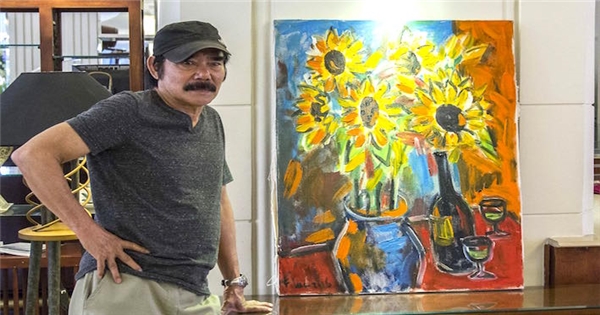
Due to regular headaches from high blood pressure, Luc has suffered from insomnia since he was 14. Many new ideas flash into his mind at night when he tosses and turns in bed. He usually has no idea whether it comes from reality or a dream, but he quickly gets the idea down on canvas. Whenever he touches a brush, his headaches ease and he feels like he is dreaming. The next day he sometimes forgets his nocturnal creativity, waking in the morning to be pleasantly surprised at the new addition to his collection.
Ben Wilkinson, representative of Harvard Kennedy University (now USA Fullbright University) in Vietnam, is a Pham Luc collector. He noted that “Pham Luc’s paintings are like windows that we can look through to understand more about the country and the people of Vietnam, both in the past wartime and the present.”
The characters in Luc’s paintings are also diverse, such as a local market, Tet paintings, heritage depictions of Quan Ho, Ca Tru and A Dao songs, Cheo or Tuong theatre the hero Thanh Giong, or the poet Nguyen Du. Women seem to inspire him more. It may be a woman in an old dress giving her son a bicycle ride during wartime, a woman looking for mussels in modern times, or an old woman selling some fruit.
His sympathy towards and love of women in his paintings brought him true love. A French woman who fell in love with his art bought many of his paintings on credit. Three years later she took him to a villa, which was the payment, and proposed to him. With his wife’s support, his paintings have been displayed in Europe and increased his fan base.
Among modern Vietnamese painters, Luc is the only one who has a fan club collecting his work. More than 100 of its members have some 6,000 of his paintings and regularly hold exhibitions. One, Tony Olive from Australia, who has 100 of Luc’s paintings, opened an exhibition in 2009 and every piece was sold. He felt regret at the scale of the exhibition’s success, however, and negotiated to buy back four of the paintings.
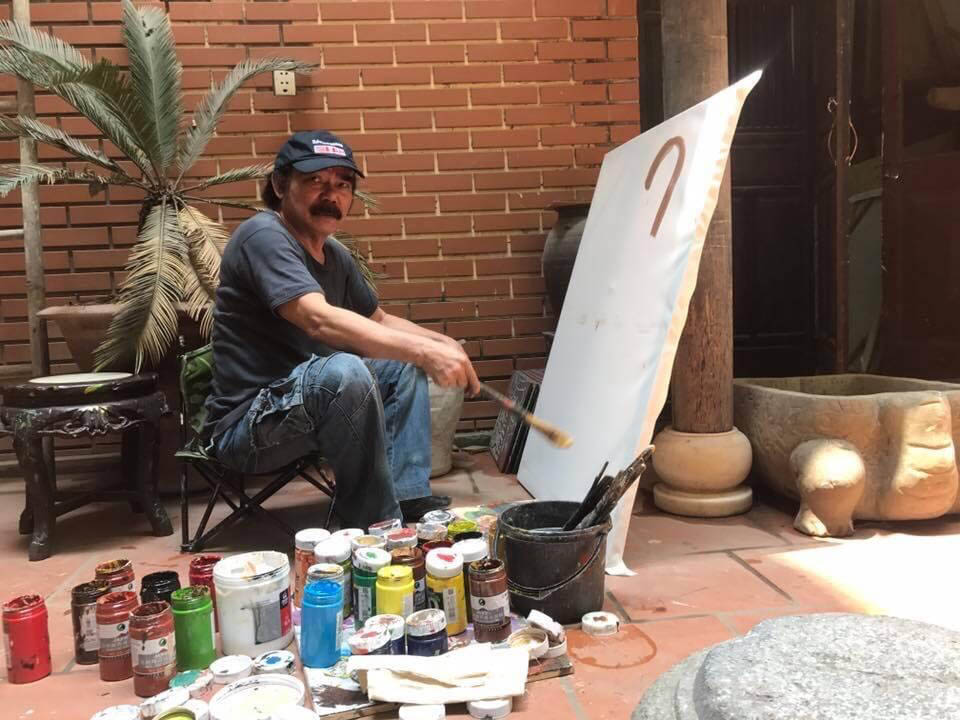
Paintings on Rice Sacks
Paintings on Rice Sacks have become synonymous with the artist Pham Luc in Vietnam. The artist, a former military painter, has experienced many battles in his lifetime. He indicates that the mission of the military painter is honest reflection about the life of people in the battlefield, what he observed and how he felt during the marches. The villages and people who helped him when he got hurt, and the fierce battlefields he passed through are featured in his works.
He painted hundreds of paintings on rice sacks made of jute or synthetic fiber rope from the Soviet Union and China. The idea to use rice sacks came about as he lacked the necessary materials to paint on, and rice sacks were plentiful.
He revealed that the first rice sack paintings were created with the artist Bang Lam in 1965. Pham Luc had to use lubricating oil from cars and trucks to draw because he lacked paints. Every character, image, and depiction in the paintings are associated with his military compatriots. Unfortunately, many paintings were damaged by bombs and ammunition.
War scenes often appear in his paintings, with subjects such as an old mother taking care of wounded soldiers, two teammates piggybacking injured soldiers back to the unit after a battle, a pregnant wife looking up at the image of her sacrificed husband, and militia girls carrying guns. Pham Luc also painted nudes on the sacks, a rather sensitive topic and a taboo in the military.
He had to use his imagination because there were no female models, and the finished pieces were often concealed. In one piece he depicts Vietnamese women soldiers taking a bath in the Truong Son Range after he had accidently come across them. In his paintings, those images bring a pure and romantic setting to the war.

Pham Luc has a distinctive style, one that reflects the culture and history of Vietnam. Many foreign and domestic collectors are proud of owning one or more of his rice sack paintings. In 2013, due to ill health, the artist stopped drawing and exhibiting this type of painting. Because of these changes, the rice sack paintings have become more sought after.
When asked why he had quit painting on rice sacks, the artist explained, “This was my toughest decision, but I’m very happy about my first exhibition without rice sack paintings. In any solo or collective exhibition, the rice sack paintings always make me different. This material reflects the misery of the whole nation at the time, and that has touched many people. But I think nothing is forever nowadays. The artist must also portray life with pen strokes and canvas.”
In a recent interview with writer Nguyen Ngoc about Pham Luc, Thomas J. Vallely, Director of the Harvard Vietnam Program, said his favorite place in Vietnam was not a city or a town but Luc’s concrete studio house. Whenever he visits Luc he talks about art and has learned new things about Vietnam, past and present. He sees Luc’s work as being rich in culture, history and heritage, through varied and diverse themes, with an artistic language on war and the difficulties and sorrows of life, making his creative value not just Vietnamese, but universal.
A masterpiece in the natural wonder
A touch of heritage in the sanctuary of the senses
By Waseem Ahmed
Vietnam’s first boutique cruise brings heritage alive, only 90 minutes away from Hanoi. Heritage Cruises showcases the country’s art, history, culture and gastronomy in the Halong Bay region.
The cultural and artistic heritage, as well as the spirit of patriotism of the entrepreneur, Bach Thai Buoi, were the inspirations for the owner of Heritage Cruises as he planned thematic experiences that will awaken the senses of guests traveling deep into the heart of Halong Bay.
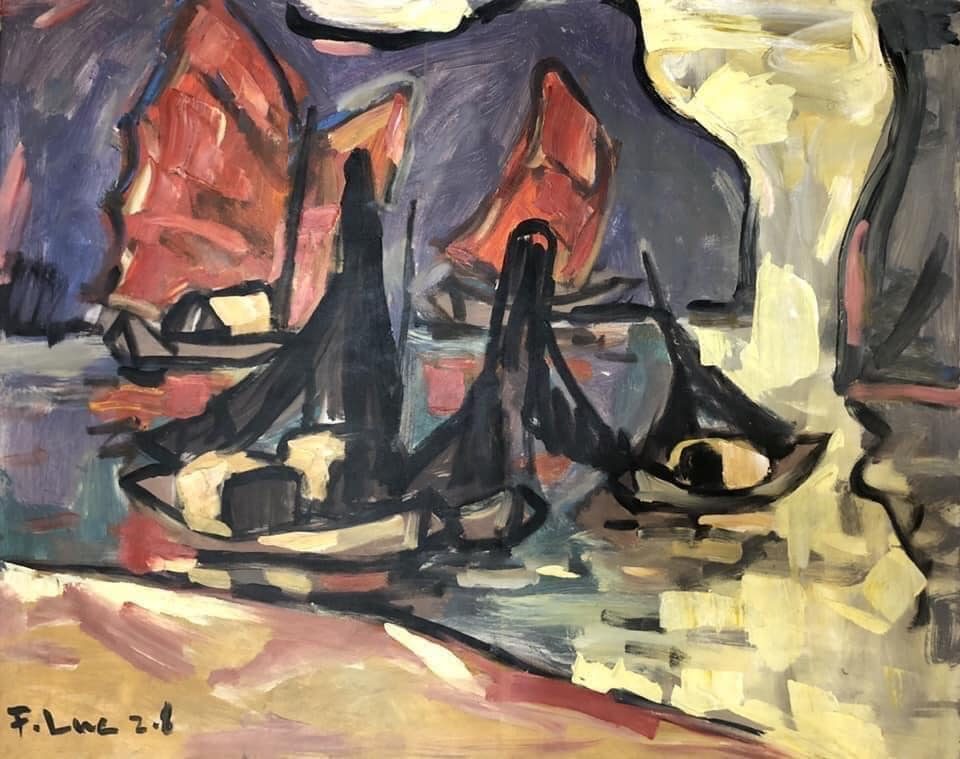
With its haute cuisine complemented by superior service, Heritage Cruises will shape the design of brand-new cruise ships and lead new boutique trends in Vietnam. Cruising is all about you and travel is about the destination, the experiences, and the memories.
For luxury travelers, the criteria for a holiday have become immutable by default: an attractive space with views over the mountains or sea, a variety of dining venues, tantalizing menus, attentive service from the heart, and outstanding facilities for discovering, exploring, immersing and relaxing on board.
With Heritage Cruises, you will be impressed by the stylish, luxurious architecture and attention to detail, where there is a work of art around every corner and everything is extremely tasteful. Our owner collected a rich collection of postcards, stamps, antiquities, ceramics, pottery, artworks, and folk paintings bringing Vietnamese culture to life.
One of the biggest, most adventurous, and most pioneering innovations in Vietnam is Lux Cruises, because of our million-dollar art collection on board. Many people think that sun, heat, wind, natural light, humidity, and sea salt can damage the paintings, but in fact the opposite is the case since the humidity is always 50% on the yacht, and the average temperature is around 72 degrees F or 22 degrees C, the ideal temperature of museums when they want to preserve their paintings well.

Loving beauty is enjoyable, but creating beauty is art. Paintings beautify and brighten up the décor space on the cruise ship. When hanging the paintings, we must be sure to avoid shaking them, but they must be easy to remove in case of fire. Special care must be taken in case of stains, with periodical maintenance by experts, and the most precious paintings are covered. The paintings are not only beautiful, but even more, the paintings of painter Pham Luc tell the story of war and peace, traditional culture, heritage, and the development of Vietnamese society through each period, which is where their true value lies. This is a unique privilege that only passengers of Heritage Binh Chuan can enjoy. 1 new message (heritagecruises.com)
Our owner collected the fine art because of his passion for painting. Pham Ha has spent 25 years collecting paintings with his love of heritage and telling the story of Vietnam’s intangible spirit through art. The story of Vietnamese art is also the history of modern Vietnam. “He is like the person chosen to succeed the king of ships, Bach Thai Buoi.”, writes the Dream Cruise Story of the Five Continents, “He pursues his passion for cruises and yachts, and builds them to display his paintings for travelers to enjoy.” After all, only the most memorable stories, the paintings, are the most valuable asset on a cruise ships.
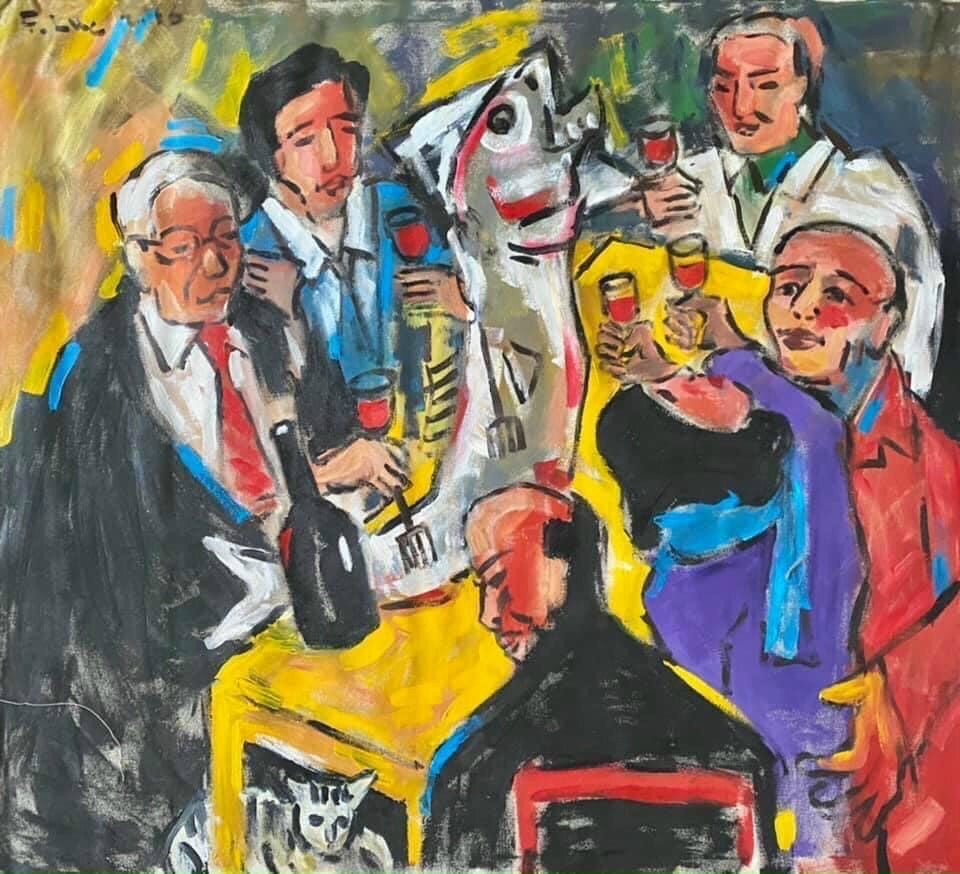
The combination of a unique boutique heritage cruise in this most special of natural wonders, Halong Bay, will resonate with our discerning guests who will savor the cultural surprises in a program where everything blends perfectly, the senses are awakened, and the scenery is emotionally uplifting. The fine cuisine in Le Tonkin and L’Indochine restaurants will enhance the experience of cruising through this paradise on earth, and travelers will love every moment, ensuring once-in-a-lifetime memories.
Outstanding facilities, a year-round swimming pool, welcoming bars, a top-notch spa, the opportunity to buy art by the Picasso of Vietnam, distinctive architectural style, haute cuisine and excellent service, this boutique cruise ship awaits the elite to discover, dream, explore, indulge, relax, experience and immerse in cultural and natural heritage.
Being a heritage-inspired designer cruise ship, but still with a boutique concept, Heritage Cruises care about the guest experience, offering them an upscale lifestyle with an artistic twist, together with concierge services.

Like boutique hotels, boutique cruises are characterized by their intimate atmosphere and idiosyncratic style. They distinguish themselves from larger chain cruises by offering personalized attention and stylish, themed accommodation and a story to tell. We want to create memorable moments that focus on the local culture and arts encountered on the way. Our boutique cruise categorizes its ships not with stars but by “character, quality, style and the overall unique experience of staying there”.
As Heritage Cruises’s first boutique cruise, which is positioned as a zero-star rating for the whole experience, we want to raise the bar for the art of cruising in the Halong Bay region. We ensure we give our clients the “ultimate in luxury and sophistication” and “out of the ordinary onboard facilities”. Your feedback and social media reviews are important to us and may even affect the official star rating of our property.” www.heritagecruises.com
DISCOVER VIETNAMESE CULTURE THROUGH PAINTINGS
Exhibiting both French and Vietnamese influences in his work, Pham Luc is a bridge linking the 20th and 21st centuries. To appreciate this accomplished and yet humble master is to understand a part of Vietnamese culture, history, heritage, progress and life.
Some of his older paintings sold for over $400,000 and many have admired his works including a Harvard professor, many ambassadors in Hanoi, high-ranking Vietnamese officials and art collectors from around the world. He has a collectors’ club with over a hundred passionate members in Hanoi.
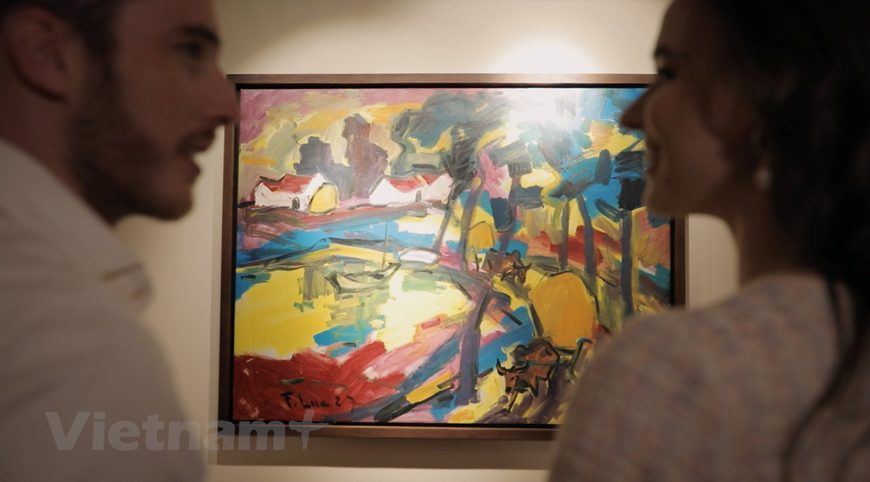
Soldier and Painter
Pham Luc was born in Hue, Vietnam in 1943 and raised in Hanoi. He was one of the official painters in the Vietnamese army and was awarded prizes in art from the Ministry of Defense in 1990. He still lives in Hanoi and is one of the major painters in this country. His works have been exhibited in France, Germany, USA, Australia, Singapore, Japan and Russia and feature in the collections of Vietnam’s Fine Arts Museum and many international art collectors.
His style
Pham Luc’s style is instantly recognizable but hard to imitate. “I do not paint in abstract. I paint the vibrations of my heart, the life of the people around me… I find serenity in working. My paintings are confessions.”
It is in these terms that the painter describes his style which is full of French influences. In his art Pham Luc exalts the simplicity of rural beauty through the sweetness of women, children or nature.
Pham Luc is influenced by four of the most famous and successful painters in Vietnam since 1945 – Nghiem, Liem, Sang and Phai who all graduated from L’Ecole des Beaux Arts de l’Indochine. These four artists diverged on totally different paths. Nghiem in a world of convention, Liem softness and femininity, Sang was strength, and Phai realism.
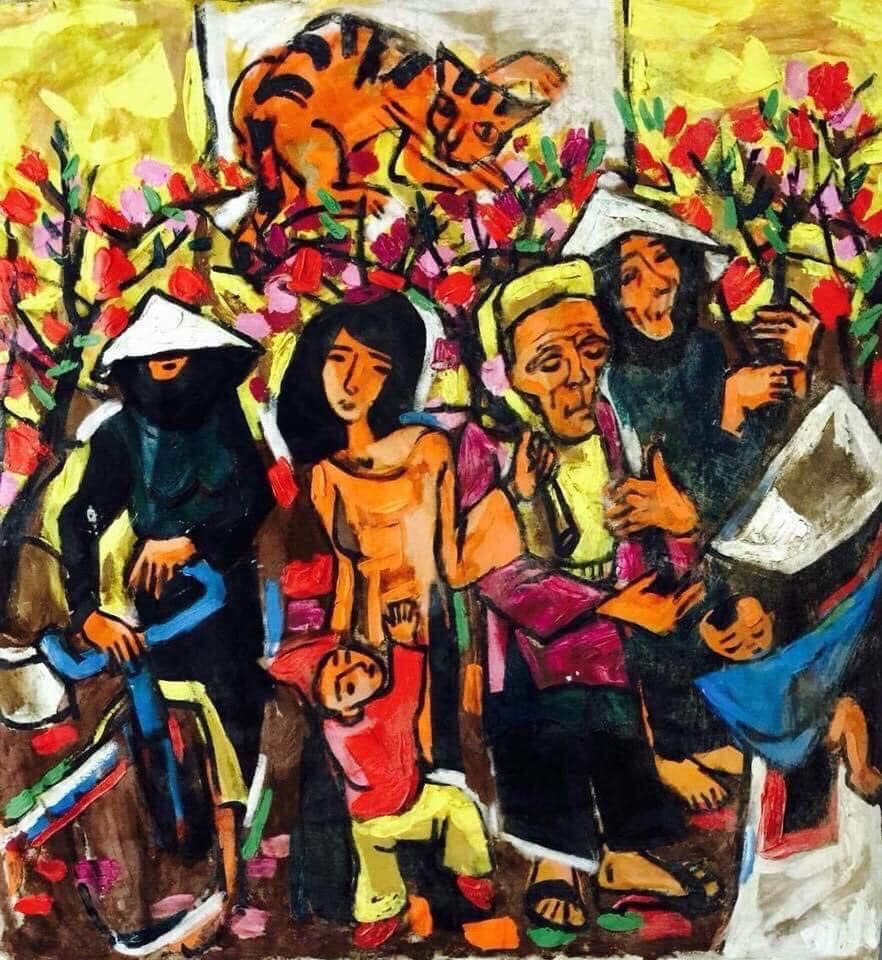
His life as a painter “Painting is my joy in life.”
Pham Luc tirelessly paints nearly a thousand paintings every year. What characterizes him is his ability to adapt to the element he is using. He has created works of art on all possible media: newsprint, craft paper, rice sacks. He also mastered the traditional techniques such as oil, gouache, ink, pastel, and lithography as well as lacquer, deemed the most difficult technique, and inaccessible to many. He is one of the acknowledged masters in this medium.
Pham Luc and war
Pham Luc spent 35 years in the army and was one of the official army painters. Much of his art was produced in haste during the war, on sacks of rice, and bore witness to the horror of the fighting that surrounded him. Art silenced the horror and introduced the essence of hope.
One particular technique: Lacquer
Initiated in China three thousand years ago, the technique of lacquer then spread throughout Southeast Asia. In Vietnam, where lacquer is recognized as a popular art and craft, the process, a long kept national secret, was allowed to be shown to foreign students around 1970 by the Hanoi Fine Arts College. What characterizes it is the application of several layers of color dried in a hot and humid atmosphere. Thanks to grinding techniques, different shapes and colors can be brought out.

Work in ink
Pham Luc’s ink works, painted on locally available materials such as silk, rice sacks, newsprint, and rice paper, are of inestimable historical value. Made between 1965 and 1975, a series of drawings in ink on rice paper represent the soldiers, Vietnamese peasants, and women during the war, mostly passive witnesses of a conflict for unity and independence.
Oils and other techniques
Pham Luc mastered many traditional techniques: from lacquer (he is an undisputed master in Vietnam), water color, oil, woodcarving, and gouache to acrylic. A book that compares him with Picasso is dedicated to him.
 A masterpiece in the natural wonder
A masterpiece in the natural wonder
Built with passion, Heritage Cruises is proudly affiliated with the master Pham Luc as travel, cruising, food, wine, hospitality, music and art represent our rich Vietnamese history, culture, nature, heritage and cuisine which all create memories for the most sophisticated travelers. Discover our masterpiece and 100 artworks on board and create your own memories.


